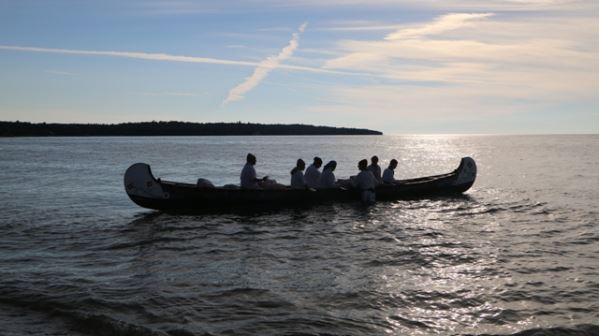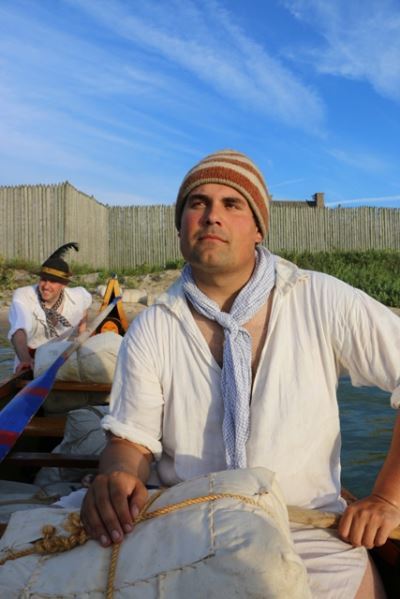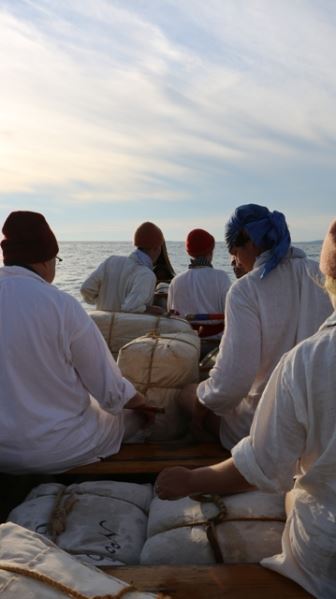 Up until the early part of the nineteenth century, canoes were the primary mode of transportation for everyone in the Great Lakes region. Craig Wilson, the curator of history at Mackinac State Historic Parks, is an expert in canoes and their meaningful impact on the Great Lakes, and he explained that the Native American communities were located largely along the lakeshore of Northern Michigan, making the canoe an ideal form of transportation for them.
Up until the early part of the nineteenth century, canoes were the primary mode of transportation for everyone in the Great Lakes region. Craig Wilson, the curator of history at Mackinac State Historic Parks, is an expert in canoes and their meaningful impact on the Great Lakes, and he explained that the Native American communities were located largely along the lakeshore of Northern Michigan, making the canoe an ideal form of transportation for them.
The canoe was then copied by the French when they arrived and later the British and Americans as well. Recognizing the lightweight, agile craft as a superior mode of transportation on the Great Lakes, everyone started building their own, imitating the Native Americans’ form and, in some cases, significantly enlarging them as well.
Timeless Design
It’s rather astounding to consider the fact that most any design of a modern 16- to 18-foot canoe that holds a couple of people is essentially identical to the ones the indigenous people were using on the Great Lakes. It’s a testament to the timeless design of the versatile vessel.
“They’re made out of different materials today,” added Craig, “since they’re not generally made out of birch bark anymore, but the same basic design of lightweight, easily maneuverable, portable vessels are still incredibly common today.”
However, then you get into the larger commercial canoes that the French started building back in the day, and those ones are not as common on the lakes now. Craig mentioned that the French took the original canoe design and kept making larger and larger versions until the Montreal canoe was born, which can range between 35 to 40 feet long. These monsters are capable of carrying 3 to 4 tons and sport the same basic design as any other canoe—just much bigger.
ones are not as common on the lakes now. Craig mentioned that the French took the original canoe design and kept making larger and larger versions until the Montreal canoe was born, which can range between 35 to 40 feet long. These monsters are capable of carrying 3 to 4 tons and sport the same basic design as any other canoe—just much bigger.
“We don’t really see them anymore,” noted Craig. “We have some reproduction here at our museum, but it’s not something that people are using on a day-to-day basis.” Since the Montreal canoes are big and heavy, they take around 10 to 12 people to paddle, so they’re just not as convenient for most people as the modern small canoe.
Material Matters
The reason the indigenous people used birch bark for the canoes is because it’s a readily available material in the area. Plus, the birch bark itself is fairly easy to harvest in a sustainable manner if you know what you’re doing.
 “If you harvest it at the right time of year, it will virtually pop off the tree without killing the tree,” shared Craig. “However, if you do it the wrong way at the wrong time of the year it will seriously damage the tree.”
“If you harvest it at the right time of year, it will virtually pop off the tree without killing the tree,” shared Craig. “However, if you do it the wrong way at the wrong time of the year it will seriously damage the tree.”
Furthermore, if you know how to do it the right way, you’ll find the birch bark to be light, flexible, waterproof, and easy to work with. All these qualities make it the perfect material to stretch over a wood frame that is typically made from cedar.
Tribute To Voyagers
To honor the voyaging canoeists on the Great Lakes, Mackinac State Historic Parks has hosted a special event every year for the past several years. It’s called the Rendezvous At The Straits, and it gives people an opportunity to focus more closely on the voyagers and canoeists that powered the economy of the whole upper Great Lakes in the eighteenth century.
These voyagers were primarily French Canadians who paddled the very large freight canoes that came from Montreal, Canada. They were responsible for transporting countless tons of trade goods on their canoes in the Great Lakes.
They’d generally bring the goods from Montreal to the Mackinaw, Mich., area where they would transfer them to another canoe. Then the trade goods would get shipped out west to the other side of Lake Michigan, going way up north to Lake Superior where they were used to purchase furs from the indigenous trappers. Afterward, the furs would make that same journey back and ultimately get shipped over to Europe where they’d be turned into all sorts of fashion items.
“The event is an opportunity for us to talk a little bit about the culture of the voyagers,” explained Craig. “They had a pretty unique French Canadian subculture with their own terminology, their own form of dress, and their own diet.”
See Them In Action
Something else the Rendezvous At The Straits does is give people a chance to learn and talk about what it was like for the voyagers to work and travel in the canoes. Mackinac State Historic Parks takes a couple of their reproduction canoes out on the Straits of Mackinac to give people the chance to see what they look like in action.
“Typically we just have them on land and people can look at them,” mentioned Craig, “but that event is also an opportunity for us to actually get out on the water and paddle around.”
The last event took place back in June and Mackinac State Historic Parks is still in the process of scheduling the exact dates for the upcoming Rendezvous At The Straits in 2020. Be sure to check their website for updates so you can plan to attend this special event to get a taste of the stunning impact canoes had on shaping the history and culture of the Great Lakes.

